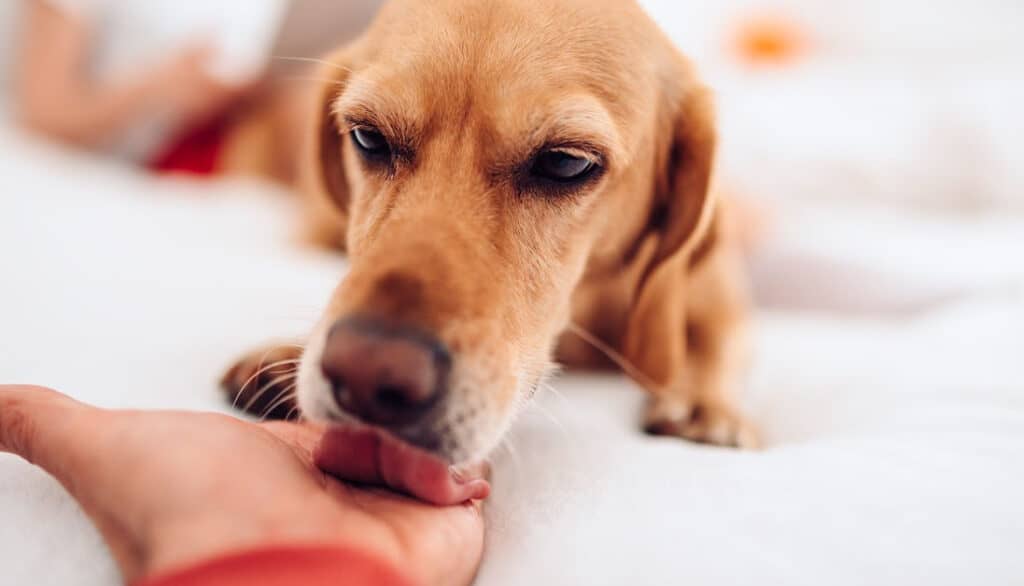Navigating the world of canine health can sometimes feel like deciphering a complex puzzle. Navigating the plethora of medications, treatments, and natural remedies can easily overwhelm us as we strive to make the best choices for our furry friends. That’s why today, we’re diving deep into the subject of Triamcinolone for dogs. You might’ve come across this name during a vet visit or while scouring the web for answers about doggy health issues.
Whatever the reason, we’re here to demystify this drug, discuss its uses, side effects, and even delve into some natural complementary products that can enhance your pet’s overall well-being. Think of this as your go-to guide, written with care and a pinch of love, to ensure your tail-wagger gets the best possible care. So, grab a cup of tea (or perhaps a dog treat for your loyal companion) and let’s embark on this informative journey together! 🐶❤️📘

What is Triamcinolone?
Triamcinolone, often nestled amidst an array of medical terminologies, is a synthetic corticosteroid. But let’s break that down in simpler terms. Corticosteroids are a type of medication that mimics the action of steroids naturally produced by our adrenal glands, and yes, your dog has them too!
This particular medication falls under the umbrella of glucocorticoids, which means it’s adept at reducing inflammation, suppressing immune responses, and even fighting certain types of cancers. Imagine it as a versatile tool in a veterinarian’s toolbox, useful for tackling a range of ailments.
Its versatility is partly what makes Triamcinolone a go-to for many vets. Whether it’s addressing skin allergies, calming down an overactive immune system, or providing relief from chronic inflammatory conditions, Triamcinolone steps in like a reliable friend, ensuring our canine buddies get the relief they so rightfully deserve.
But, like all medicines, it’s not just about knowing the ‘what’, but also the ‘how’, ‘when’, and ‘why’. So, as we explore further, you’ll get a comprehensive view of how Triamcinolone can play a role in your dog’s healthcare journey. Stick with us; we’re just scratching the surface! 🐕🩺🌟

Uses of Triamcinolone in Dogs
It’s a beautiful thing, watching our dogs play, explore, and enjoy life’s simple pleasures. But, as with all creatures, they too can face health challenges. In such times, medicines like Triamcinolone step in to lend a helping paw. Let’s dive into the array of uses this versatile medication offers for our canine companions.
1. Anti-Inflammatory Superstar:
Inflammation can be a real dampener, causing discomfort, pain, or even chronic ailments. Triamcinolone acts like a superhero cape for our pets, combatting inflammation in conditions such as allergies, skin conditions, or joint pain. Its powerful anti-inflammatory properties provide much-needed relief, ensuring that wagging tail doesn’t miss a beat!
2. Immunosuppressive Agent:
While a robust immune system is generally a boon, sometimes it can become too active, targeting the body’s own cells. Autoimmune disorders, where the body mistakenly attacks itself, can be distressing. That’s where Triamcinolone steps in, calming the immune system and ensuring it doesn’t go into overdrive.
3. Tackling Addison’s Disease:
Hypoadrenocorticism, more commonly known as Addison’s disease, is a condition where the body doesn’t produce enough corticosteroids. Triamcinolone can act as a supplement, helping to balance out the body’s internal environment and alleviate symptoms.
4. An Antineoplastic Agent:
While it’s a heart-wrenching topic, some dogs do face the challenge of cancer. In specific cases, you can use Triamcinolone as an antineoplastic or anticancer agent to combat this formidable foe.
Understanding the uses of Triamcinolone provides a foundation, but it’s essential to remember that, like all medications, it’s vital to use it under the guidance of a trusted veterinarian. They will ensure that the treatment fits your pet’s specific needs and condition perfectly. After all, each dog is unique, and you should tailor their healthcare specifically for them!

Triamcinolone Dosage Chart
Please note: This chart is a general guideline. Always consult with your veterinarian for the precise dosage tailored to your dog’s specific needs.
| Weight of Dog | Dosage for Anti-Inflammatory | Dosage for Immunosuppression | Dosage for Addison’s Disease | Dosage for Antineoplastic Use |
|---|---|---|---|---|
| Up to 10 lbs | 0.25 – 0.5 mg | 0.5 – 1 mg | 0.25 – 0.5 mg | Consult Vet |
| 11-20 lbs | 0.5 – 1 mg | 1 – 2 mg | 0.5 – 1 mg | Consult Vet |
| 21-40 lbs | 1 – 2 mg | 2 – 4 mg | 1 – 2 mg | Consult Vet |
| 41-60 lbs | 2 – 3 mg | 3 – 6 mg | 2 – 3 mg | Consult Vet |
| 61-80 lbs | 3 – 4 mg | 4 – 8 mg | 3 – 4 mg | Consult Vet |
| Over 80 lbs | 4 – 5 mg | 5 – 10 mg | 4 – 5 mg | Consult Vet |
- Anti-Inflammatory: Used for conditions where inflammation is the primary concern, such as allergies, certain skin conditions, or arthritic joint pain.
- Immunosuppression: In cases of autoimmune disorders, we often need to suppress the immune system.
- Addison’s Disease: For the treatment and management of hypoadrenocorticism, where the body does not produce sufficient corticosteroids.
- Antineoplastic Use: The dosage for cancer treatments varies significantly based on the type of cancer, stage, and other individual factors. Always consult with a veterinarian for this.
Disclaimer: This chart is meant to provide a general overview. Individual needs can vary based on the dog’s health condition, age, other medications, and more. Always rely on a veterinarian’s expert advice when administering Triamcinolone or any other medication.

Available Forms of Triamcinolone
Triamcinolone, like many medications, comes in various forms to cater to different needs and conditions. This versatility ensures that administering the medication is as convenient and effective as possible for our four-legged companions. Let’s delve into these different avatars of Triamcinolone and understand their unique characteristics.
1. Liquids:
- Description: This is a solution form of Triamcinolone, often available as an oral suspension.
- Usage: It’s generally given directly into the dog’s mouth using a dropper or mixed with a small amount of food.
- Benefits: Liquid forms allow for easy dose adjustments and can be a boon for pets that are resistant to swallowing pills.
2. Oral Tablets/Capsules:
- Description: These are the most common forms and come as pills or capsules containing a specific amount of Triamcinolone.
- Usage: Given directly by mouth, often hidden inside a treat or pill pocket to make ingestion easier.
- Benefits: They provide a precise dosage, are easy to administer for most dogs, and can be stored conveniently.
3. Injections:
- Description: Triamcinolone injections deliver the drug directly into the bloodstream or a specific area.
- Usage: Administered by a veterinarian, these can be given into a muscle (intramuscular), under the skin (subcutaneous), or directly into a joint or lesion.
- Benefits: Rapid action, suitable for dogs that cannot or should not take oral medications, and beneficial for localized conditions like specific joint inflammations.
4. Topical Preparations:
- Description: These are creams, ointments, or gels containing Triamcinolone, designed for external application.
- Usage: Applied directly to the affected skin areas.
- Benefits: Direct treatment of skin conditions, reduced systemic effects compared to oral forms, and provides localized relief.
Choosing the right form of Triamcinolone for your dog depends on the condition being treated, the dog’s preferences, and the veterinarian’s recommendations. Each form has its pros and cons, but the overarching goal remains the same: to provide relief and support for our beloved pets in their times of need. As always, it’s imperative to follow the vet’s guidance when it comes to administering any form of medication. 🐶💊🌈

Side Effects of Triamcinolone in Dogs
Every medication, no matter how beneficial, comes with the potential for side effects. Understanding these is crucial so you can keep a watchful eye on your canine companion and ensure they remain in the pink of health. Here’s a breakdown of the side effects that may arise from administering Triamcinolone to dogs:
1. Increased Thirst and Urination:
Triamcinolone, like other corticosteroids, can lead to polydipsia (increased thirst) and polyuria (increased urination). You might notice your dog drinking more water and needing more frequent potty breaks.
2. Increased Appetite:
Dogs on Triamcinolone might show an increased appetite, sometimes leading to weight gain.
3. Gastrointestinal Issues:
Stomach upset, including vomiting and diarrhea, can occasionally occur. Long-term use might also increase the risk of gastric ulcers.
4. Suppressed Immune System:
Being an immunosuppressive agent, Triamcinolone can potentially make your dog more susceptible to infections.
5. Behavioral Changes:
Some dogs might exhibit signs of restlessness, anxiety, or even aggression. Others might seem lethargic or depressed.
6. Skin and Coat Changes:
Prolonged use can lead to a thinner coat, dry skin, or the development of acne or hot spots.
7. Muscle Weakness:
In some cases, dogs might exhibit signs of muscle loss or weakness.
8. Delayed Healing:
Wounds or infections might take longer to heal due to the immunosuppressive nature of the drug.
9. Development of Cushing’s Disease:
With prolonged use at high doses, there’s a risk of inducing Cushing’s disease, a condition where the body produces too much cortisol.
10. Potential for Diabetes:
Long-term use can increase the risk of diabetes, especially in predisposed dogs.

A Few Points to Ponder:
- Short-Term vs. Long-Term: While short-term use is generally safe, prolonged use increases the risk of side effects. It’s essential to weigh the benefits against potential risks.
- Communication is Key: Always keep an open line of communication with your vet. If you notice any unusual behavior or symptoms in your dog, it’s vital to bring it to their attention promptly.
- Every Dog is Unique: Just like humans, dogs can react differently to medications. What might cause side effects in one dog might be completely benign for another.
Being informed empowers you to offer the best care for your furry friend. While Triamcinolone can be a wonderful aid in treating various conditions, always remain observant and proactive in monitoring your dog’s health. After all, they rely on us to ensure they live their happiest, healthiest lives! 🐾❤️🔍

Drug Interactions
Just like when we mix different ingredients in a recipe, combining medications can sometimes result in unexpected outcomes. It’s essential to be aware of potential drug interactions, ensuring the safety and well-being of our pets. Here’s a rundown of some interactions to consider when your dog is on Triamcinolone:
1. Non-Steroidal Anti-Inflammatory Drugs (NSAIDs):
Examples include aspirin, carprofen (Rimadyl), and meloxicam (Metacam). Combining Triamcinolone with these drugs can increase the risk of gastrointestinal ulcers or bleeding.
2. Diuretics:
Medications like furosemide (Lasix) can potentially enhance the potassium-depleting effects of corticosteroids, leading to lower potassium levels in the body.
3. Vaccines:
Since Triamcinolone suppresses the immune system, it may reduce the efficacy of vaccines or increase the risk of neurological reactions to certain vaccines.
4. Insulin:
Corticosteroids can alter blood glucose levels. If your dog is diabetic and on insulin, the insulin dosage might need adjustment when Triamcinolone is introduced.
5. Certain Antifungal Medications:
Drugs like ketoconazole can increase the potency and duration of Triamcinolone, potentially intensifying its effects and side effects.
6. Phenobarbital:
Long-term use of this medication can reduce the efficacy of Triamcinolone.
7. Anticholinesterase Agents:
Used to treat myasthenia gravis, these agents can cause severe muscle weakness when combined with corticosteroids.
8. Digoxin:
Triamcinolone can elevate the risk of arrhythmias when administered alongside digoxin.
A Couple of Crucial Points:
- Open Dialogue: Before starting Triamcinolone, always provide your vet with a comprehensive list of all medications, supplements, and over-the-counter treatments your dog is taking. An informed vet is the best defense against harmful interactions.
- Observe and Report: If you notice any unusual behavior or symptoms in your dog after introducing a new medication or changing dosages, contact your vet immediately.
Understanding potential drug interactions is essential in ensuring that all medications work harmoniously in benefiting your dog’s health. Remember, while it might seem like a lot to keep track of, your vet is always there to guide you through the process. Trust in their expertise and always prioritize open communication for the sake of your furry family member’s well-being. 🐶💊🤝

How Long Does Triamcinolone Last?
Understanding the duration of a drug’s effect is crucial for maintaining effective and consistent treatment. It helps caregivers know when the next dose is due and what to expect in terms of relief and potential side effects. Here’s a breakdown of how long Triamcinolone typically lasts in dogs:
1. Duration of Action:
Triamcinolone is a medium to long-acting corticosteroid. Once administered:
- Oral Tablets/Capsules: The effects can last anywhere from 12 to 48 hours, with most dogs requiring once or twice-daily dosing.
- Injections: Depending on the specific formulation and the condition being treated, the effects of an injection can last from a few days to several weeks.
- Topical Preparations: The duration largely depends on the condition of the skin, the severity of the issue, and how the skin metabolizes the drug, but generally, relief can be seen for 12-24 hours.
- Liquids: Much like the oral tablets, the effects can last from 12 to 48 hours.
2. Factors Influencing Duration:
- Metabolism: Just as every dog has its own unique personality, each one metabolizes drugs differently. Some dogs might process Triamcinolone more quickly than others.
- Health Conditions: Dogs with liver or kidney issues might metabolize the drug slower or faster than dogs without such conditions.
- Age: Older dogs may process medications more slowly than their younger counterparts.
3. What to Remember:
- Consistency is Key: It’s important to administer the medication at the same times each day to maintain a consistent level of the drug in the dog’s system, especially for conditions that require continuous suppression, like allergies or autoimmune disorders.
- Missed Doses: If you miss a dose, give it as soon as you remember. However, if it’s close to the time of the next dose, skip the missed dose and resume the regular schedule. Avoid doubling up, as this can lead to increased side effects.
Triamcinolone’s longevity in a dog’s system is influenced by multiple factors, from the specific form of medication to the individual characteristics of the dog. Always follow your vet’s dosage recommendations and keep an eye out for any signs that might indicate the need for an adjustment. Remember, the aim is consistent relief, and understanding the drug’s duration helps ensure your pet remains comfortable and happy. 🐾🕰️💙

How to Administer Triamcinolone to Your Dog
Ensuring the correct administration of medication is just as crucial as the drug itself. Proper administration guarantees that the medication is most effective while minimizing potential discomfort for your furry friend. Here’s a step-by-step guide on how to administer Triamcinolone to your dog:
1. Oral Tablets/Capsules:
- Step 1: Check the prescribed dose and ensure you have the correct number of tablets or capsules.
- Step 2: If your dog is eager, try giving the pill directly as a “treat.” If they’re skeptical, consider using pill pockets, wrapping it in a tasty treat, or disguising it in their food.
- Step 3: Ensure they swallow it! Some dogs are crafty about spitting out medication.
2. Liquids:
- Step 1: Shake the bottle if instructed. Draw up the correct dose using the provided dropper or syringe.
- Step 2: Approach your dog calmly and gently open their mouth.
- Step 3: Administer the liquid on the side of their mouth, allowing them to swallow. It can help to offer a tasty treat afterward as a reward.
3. Injections:
- NOTE: Unless you’ve been specifically trained by your vet, it’s likely they will handle injection administration.
- Step 1: Ensure the injection site is clean.
- Step 2: If administering at home, draw up the correct dose into a sterile syringe, ensuring no air bubbles.
- Step 3: Inject as instructed by your vet – subcutaneously (under the skin) or intramuscularly (into the muscle).
4. Topical Preparations:
- Step 1: Ensure the affected area is clean and dry.
- Step 2: Apply the cream, ointment, or gel as directed. This might be a thin layer or a specific amount.
- Step 3: Prevent your dog from licking or scratching the area. This might require the use of a cone or e-collar.
General Tips:
- Stay Calm and Positive: Your demeanor influences your pet. Stay calm and use a reassuring tone.
- Reward Good Behavior: Praise your dog and give them a treat or extra attention after administering the medication.
- Stick to a Schedule: Administering the medication at the same time each day helps maintain consistent levels in the body and establishes a routine.
- Store Properly: Ensure that Triamcinolone is stored as per the instructions, away from light, heat, and out of reach of children and pets.
- Wash Your Hands: Especially if handling topical preparations, always wash your hands before and after administration.
Remember, administering medication is a process that becomes more manageable with practice. Don’t be disheartened if the first few times are challenging. Always communicate any difficulties to your vet – they can offer additional guidance or alternative solutions to make the process smoother for both you and your four-legged buddy. 🐾💊🤗

Complementary Natural Products to Enhance Treatment
Dr. Candy’s Recommendations
While modern medications like Triamcinolone offer powerful benefits, many pet parents look for complementary natural products to support their dog’s overall well-being. These products, when used correctly, can enhance the primary treatment, providing a more holistic approach to canine health. Here’s a spotlight on some natural complementary products to consider:
Relaxing Essential Oils
- Lavender: Known for its soothing properties, lavender can help calm an anxious or stressed dog.
- Chamomile: Similar to its effects in humans, chamomile can provide relaxation and mild sedation to dogs.
- Note: Always dilute essential oils and ensure they are pet-safe. Use them in diffusers or special pet aromatherapy products, keeping the dog’s sensitive sense of smell in mind.
Adrenal Herb Tinctures:
- Ashwagandha: An adaptogenic herb that helps the body cope with stress and supports overall vitality.
- Rhodiola: Another adaptogen, it can support the body’s energy reserves and resilience.
Homeopet Stress and Thunder Tincture:
- This natural remedy can help alleviate symptoms of anxiety, especially during thunderstorms or other stressful situations. It acts gently without sedating the pet.
CBD Drops or Treats:
- Cannabidiol (CBD), derived from hemp plants, has garnered attention for its potential anti-inflammatory and calming effects. It can be a great complementary option, especially for dogs dealing with pain or anxiety.
Probiotics:
- Especially if your dog has had any gastrointestinal side effects from medications, probiotics can help restore gut balance, ensuring optimal digestion and nutrient absorption.
Points to Keep in Mind:
- Consultation: Always consult your veterinarian before adding any natural or complementary products to your dog’s treatment plan. They can provide guidance on dosages and ensure there’s no interference with primary medications.
- No Direct Replacements: Remember, while these products can support and enhance, they are not direct replacements for any medication. It’s essential to continue the primary treatment as prescribed by your vet.
- Individual Responses: Just like humans, every dog is unique. Monitor your pet’s response to any new product and adjust (under veterinary guidance) as necessary.
Blending modern medicine with natural remedies can offer a comprehensive approach to canine health. By ensuring everything works in harmony, you’re giving your furry friend the best chance at a happy, healthy life. 🌿🐾❤️

Conclusion
Our four-legged companions rely on us to provide them with the best care, both medically and holistically. In navigating the vast landscape of canine health, the power of knowledge cannot be understated. With Triamcinolone offering a potent solution for specific health issues, it’s essential to be well-informed about its uses, dosages, and potential interactions. Moreover, blending modern medications with complementary natural products, like the Standard Process Canine Adrenal Support, can offer a comprehensive approach to well-being, ensuring our furry friends lead vibrant, comfortable lives.
As pet parents, we always want the best for our beloved dogs. And while the journey to optimal health can sometimes be overwhelming, remember that every step taken is a stride towards happier tails and brighter doggy smiles. So, here’s to informed choices, holistic health, and the unbreakable bond we share with our canine companions. 🐾❤️🌟
Frequently Asked Questions
In animals, triamcinolone can be used to treat hypoadrenocorticism (Addison’s disease) and can be used as an anti-inflammatory drug, immunosuppressive drug, and antineoplastic (anticancer) agent. Dosages vary for all of these uses. The FDA (U.S. Food & Drug Administration) has approved some triamcinolone products for use in dogs, cats, and horses. The FDA allows veterinarians to prescribe products containing this drug in different species or for other conditions in certain situations. For
other FDA-approved triamcinolone products for use in humans, the FDA allows veterinarians to prescribe these products in animals in certain situations. You and your veterinarian can discuss why this drug is the most appropriate choice.
Many things might affect how well this drug will work in your animal. Be sure to discuss the following with your veterinarian so together you can make the best treatment decisions.
– Other drugs can affect the way this drug works, so be sure to tell your veterinarian and pharmacist what medications (including vitamins, supplements, or herbal therapies) you give your animal, including the amount and time you give each.
– Tell your veterinarian about any conditions or diseases your animal may have now or has had in the past.
– If your animal has been treated for the same disease or condition in the past, tell your veterinarian about the treatment and how well it worked or didn’t work.
– If your animal is pregnant or nursing, talk to your veterinarian about the risks of using this drug.
– Tell your veterinarian and pharmacist about any medication side effects (including allergic reactions, lack of appetite, diarrhea, itching, hair loss) your animal has developed in the past.
This medication should help your animal feel better within 1 to 2 hours. Your animal’s clinical signs should improve after that time. The effects of this medication are moderate in duration, meaning they may last for a few days, although the benefits may be prolonged if your animal has decreased kidney and/or liver function.
No drug is 100% safe in all patients, but your veterinarian will discuss with you any specific concerns about using this drug in your
animal.
Triamcinolone SHOULD NOT be used in patients:
– That are allergic to it.
– With a systemic fungal infection (unless using it during an Addisonian crisis).
– With viral infections.
– That have stomach or intestinal ulcers.
– With untreated Cushing’s disease (too much stress hormone being made in the body).
Triamcinolone should be used WITH CAUTION in patients:
– That are receiving other drugs that can cause stomach ulcers, including aspirin or NSAIDs (eg, carprofen, flunixin, meloxicam).
– That have diabetes.
– That have cardiovascular or heart disease.
– That are pregnant.
– That have a bacterial infection.
– That are young and growing. These drugs can affect(stunt) growth when used for a long time.
If your animal has any of these conditions, talk to your veterinarian about the potential risks versus benefits.
Side effects that usually are not serious include:
– Greater appetite, thirst, and need to urinate.
– Vomiting, diarrhea.
– Mild behavioral changes.
– Panting more than normal (in dogs).
You don’t have to be overly concerned if you see any of these unless they are severe, worsen, or continue to be a problem. Contact your veterinarian if this happens.
– Stomach or intestinal ulcers/perforation/bleeding. If your animal stops eating, or you see a high fever, black tarry stools or bloody vomit(coffee ground appearance), contact your veterinarian immediately.
– After using the drug for several weeks or more: weight gain, pot belly, skin or coat changes, hair loss, or weakness, any of which may mean the dose is too high. If you see any of these signs, contact your veterinarian.
– Excessive thirst and urination with excessive appetite in the face of weight loss. These signs can be seen commonly with this drug, but may also indicate diabetes.
– Severe behavioral changes (eg, aggression/threatening actions). Contact your veterinarian immediately if this occurs.
– Low energy level may indicate an infection. Because triamcinolone can suppress immune function when used at high dosages, patients are susceptible to infections. Lethargy may be the only sign you see as the typical signs (fever, frequent or painful urination) alerting you of an infection are masked by the medication.
– If you are concerned about the possibility of infection, contact your veterinarian immediately.
Contact your veterinarian or an animal poison control center for further advice if an overdose is suspected. Animal poison control centers that are open 24 hours a day include: Pet Poison HELPLINE (855-764-7661) and ASPCA Animal Poison Control Center (888-426-4435); a consultation fee is charged for these services.
For this medication to work, give it exactly as your veterinarian has prescribed. It’s a good idea to always check the prescription label to be sure you are giving the drug correctly.
– Give medication with food. This may help prevent vomiting after a dose and possibly prevent stomach ulcers or bleeding.
– Triamcinolone is usually given in the morning to dogs and horses, and in the evening to cats, as this will more closely mimic their natural hormone cycles.
– Your veterinarian may prescribe a tapering (reducing) dose of this medication. More medication is given early in therapy and the dose is slowly reduced over time. If you have any questions on how much or how often to give this medication, consult with your veterinarian or pharmacist.
– Liquid forms of this medication must be measured carefully. Your veterinarian or pharmacist can help by providing special measuring spoons or syringes.
– Triamcinolone can be very bitter-tasting. If you have difficulty getting your animal to take the medicine, contact your veterinarian or pharmacist for tips to help with dosing and reducing the stress of medication time.
– This medication can be given for various lengths of time. Be sure you understand how long the veterinarian wants you to continue giving this medication. Prescription refills may be necessary before the therapy will be complete. Before stopping this medication, talk to your veterinarian, as there may be important reasons to continue its use.
– It is very important to not stop the drug abruptly if your animal has been on it for a while as serious side effects could occur.
If you miss a dose, give it when you remember, but if itis close to the time for the next dose, skip the dose you missed and give it at the next scheduled time. After that, return to the regular dosing schedule. Do not double-up or give extra doses.
– Store this medication in the original prescription bottle or an approved dosage reminder container (ie, pill minder) at room temperature and protected from light.
– If your veterinarian or pharmacist has made (compounded) a special formulation for your animal, follow the storage recommendations and expiration date for the product.
– Keep away from children and other animals.
There are no specific precautions required when handling this medication unless you are allergic to it. Wash your hands after handling any medication.
– Do not flush this medication down the toilet or wash it down the sink. If a community drug “take-back” program is available, use this option. If there is no take-back program, mix the drug with coffee grounds or cat litter (to make it undesirable to children and animals and unrecognizable to people who might go through your trash), place the mixture in a sealable plastic bag to keep it from leaking out, and throw the bag out with the regular trash.
– Do not save leftover medication for future use or give it to others to use.
– Your veterinarian will need to do periodic examinations and blood tests on your animal while it is taking this medicine. Do not miss these important follow-up visits.
– If your animal has been on high doses of triamcinolone, vaccinations may not be effective. Talk to your veterinarian about keeping your animal protected while your animal is receiving the drug.
– If you are seeing a different veterinarian than normal, be sure to tell them your dog is taking this drug. Dogs that require surgery or are stressed from trauma or illness may require additional glucocorticoid drugs. This medicine can also affect some laboratory tests.
– Use of this drug may not be allowed in certain animal competitions. Check rules and regulations before entering your animal in a competition while this medication is being administered.
– If your animal is scheduled for allergy testing, your veterinarian will give instructions about when to discontinue this medicine to avoid interfering with test results.
